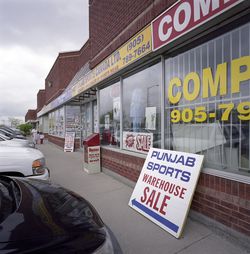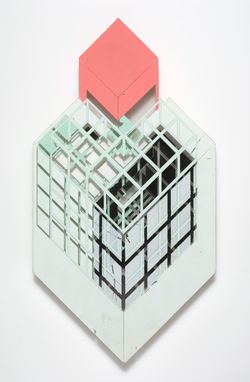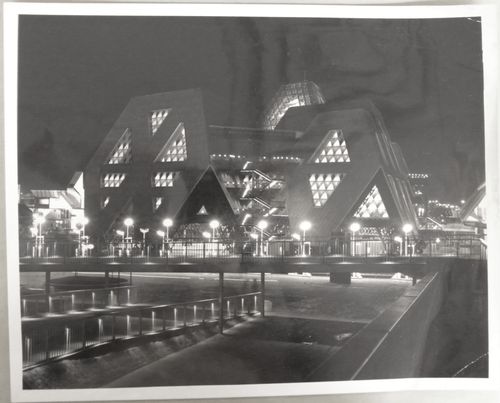born digital
Drawing of the provincial government building, Thunder Bay, Ontario, 5.25" floppy disk, 1.2 MB
ARCH280521
Description:
Labelled: "A6-7 87013; Ex. wall details; Scale 1:2". File Format: AutoCAD Drawing. Complementary files are missing, which causes the DWG file to fail opening properly. This floppy disk is part of a group of 4 and is wrapped in a transmittal note addressed to Reg Nalezyty.
1989
Drawing of the provincial government building, Thunder Bay, Ontario, 5.25" floppy disk, 1.2 MB
Actions:
ARCH280521
Description:
Labelled: "A6-7 87013; Ex. wall details; Scale 1:2". File Format: AutoCAD Drawing. Complementary files are missing, which causes the DWG file to fail opening properly. This floppy disk is part of a group of 4 and is wrapped in a transmittal note addressed to Reg Nalezyty.
born digital
1989
archives
Level of archival description:
Fonds
Robert Duchesnay fonds
AP115
Synopsis:
Le Fonds Robert Duchesnay consiste en une série de photographies montrant les divers structure (principalement des dômes géodésiques) conçus ou influencée par R. Buckminster Fuller. Les photographies, prises par l'artiste et photographe montréalais Robert Duchesnay, ont été créées entre 1985 et 1992.
1985-1992
Robert Duchesnay fonds
Actions:
AP115
Synopsis:
Le Fonds Robert Duchesnay consiste en une série de photographies montrant les divers structure (principalement des dômes géodésiques) conçus ou influencée par R. Buckminster Fuller. Les photographies, prises par l'artiste et photographe montréalais Robert Duchesnay, ont été créées entre 1985 et 1992.
archives
Level of archival description:
Fonds
1985-1992
textual records
Symposium: “Towards a Theory of the Humanities”; University of South California; Nov. 17-19, 1977.
ARCH153866
Description:
Peter Eisenman : “The Teaching of Architecture as a Humanist Discipline”; David Howard Bell: “Unity & Aesthetics of Incompletion”; Nancy S. Struever: "Humanities and Humanists" ? : “The Public Function of Humanities Marshall Cohen : “Remarks on Postmodernism: An Outline” Adolf Grümbaum : “The Role of Psychological Explanations of the Rejections or Acceptance of Scientific Theories”. Bersani : ? Louch : “Professions, Disciplines & The Humanities” Philip Fisher : “The Recovery of the Body” D.L. Rosenbau : “Causes and Faults”
1977
Symposium: “Towards a Theory of the Humanities”; University of South California; Nov. 17-19, 1977.
Actions:
ARCH153866
Description:
Peter Eisenman : “The Teaching of Architecture as a Humanist Discipline”; David Howard Bell: “Unity & Aesthetics of Incompletion”; Nancy S. Struever: "Humanities and Humanists" ? : “The Public Function of Humanities Marshall Cohen : “Remarks on Postmodernism: An Outline” Adolf Grümbaum : “The Role of Psychological Explanations of the Rejections or Acceptance of Scientific Theories”. Bersani : ? Louch : “Professions, Disciplines & The Humanities” Philip Fisher : “The Recovery of the Body” D.L. Rosenbau : “Causes and Faults”
textual records
1977
Learning from… Toronto
Ian Chodikoff, architect, urban designer, and editor of Canadian Architect magazine, presents his research on the contemporary suburb and how the influences of ethnic diversity and multiculturalism affect architecture and urban design within the suburban landscape across the Greater Toronto Area (GTA). Today’s suburbs are more ethnically diverse, globally connected and(...)
Paul Desmarais Theatre
4 March 2010 , 7pm
Learning from… Toronto
Actions:
Description:
Ian Chodikoff, architect, urban designer, and editor of Canadian Architect magazine, presents his research on the contemporary suburb and how the influences of ethnic diversity and multiculturalism affect architecture and urban design within the suburban landscape across the Greater Toronto Area (GTA). Today’s suburbs are more ethnically diverse, globally connected and(...)
Paul Desmarais Theatre
Through the work of internationally renowned architects, this exhibition reveals the presence of utopian modernist ideas thought to have been discarded with the advent of the postmodern era. According to the exhibition’s lead curator Reinhold Martin, much of the architectural production of the last half-century has been haunted by the ghosts of modernist utopias: “The(...)
Octagonal gallery
28 February 2008 to 25 May 2008
Utopia's Ghost: Postmodernism Reconsidered
Actions:
Description:
Through the work of internationally renowned architects, this exhibition reveals the presence of utopian modernist ideas thought to have been discarded with the advent of the postmodern era. According to the exhibition’s lead curator Reinhold Martin, much of the architectural production of the last half-century has been haunted by the ghosts of modernist utopias: “The(...)
Octagonal gallery
Sub-series
Awards and honours
AP075.S3.SS3
Description:
This sub-series documents the awards and honours received by Cornelia Hahn Oberlander for her work as a landscape architect or awards for landscape projects. It includes design awards from Landscape architecture associations, such as the President's Award to Excellence from the American Society of Lanscape Architects (ASLA) for Robson Square in Vancouver in 1971, or the Canadian Society of Lanscape Architects (CSLA) award for the Canadian Chancery in Washington D.C. in 1991. It also contains honoris cause she received from universities or documents related to the been nomiated as Officer of the Order of Canada in 2009 or as Companion of the Order of Canada in 2018. The sub-series contains the awards, medals, trophies and certificats she received, invitations to official celebrations, a few recordings of the award ceremonies, photographs, and other correspondence and administrative documents related to the planning of ceremonies.
1950-2018
Awards and honours
Actions:
AP075.S3.SS3
Description:
This sub-series documents the awards and honours received by Cornelia Hahn Oberlander for her work as a landscape architect or awards for landscape projects. It includes design awards from Landscape architecture associations, such as the President's Award to Excellence from the American Society of Lanscape Architects (ASLA) for Robson Square in Vancouver in 1971, or the Canadian Society of Lanscape Architects (CSLA) award for the Canadian Chancery in Washington D.C. in 1991. It also contains honoris cause she received from universities or documents related to the been nomiated as Officer of the Order of Canada in 2009 or as Companion of the Order of Canada in 2018. The sub-series contains the awards, medals, trophies and certificats she received, invitations to official celebrations, a few recordings of the award ceremonies, photographs, and other correspondence and administrative documents related to the planning of ceremonies.
Sub-series
1950-2018
Project
AP001.S6.1924.PR04
Description:
La construction de l’Université de Montréal s’est effectuée sur plusieurs années. Cormier est architecte en chef entre 1924 et 1947 et agit à titre d’architecte-conseil et d’ingénieur-conseil entre 1950 et 1961. Il semblait inévitable de diviser le cadre de classement en deux phases pour bien distinguer le rôle et l’implication de Cormier qui diffère durant ces deux périodes. La présence de deux plans d’ensembles très différents proposés en 1931 et 1961 appuie cette décision. Cette première phase s’étend sur une aussi longue période puisque le processus de construction a été parsemé de problèmes logistiques et financiers. Dès le début des travaux, le sol cause des problèmes lors de l’excavation et engendre des coûts supplémentaires en plus de retarder le processus. Avec la crise financière qui frappe en 1929, les travaux sont progressivement stoppés. De plus, les conditions météorologiques vont endommager une partie de la toiture et de la maçonnerie qui avait déjà été entamée, ce qui vient encore une fois engendrer des coûts additionnels. Suite au contexte économique particulier, l’administration de l’UdeM demande l’aide financière du gouvernement provincial pour protéger ce qui avait déjà été construit du pavillon principal. Le bâtiment sera finalement repris en 1943 et inauguré en 1947. Suite aux nombreux problèmes qui parsèmeront la première phase, le plan initial proposé par Cormier qui comprenait un stade, un aréna et la maison des animaux, sera abandonné au détriment du pavillon principal. Les projets non-réalisés sont tout de même documenté dans leurs sous-séries respectives. Il est important de prendre note que les plans produits par Cormier concernant les ailes du pavillon principal qui allaient servir de Centre Hospitalier ne seront jamais réalisés. Différents départements vont plutôt occuper l’espace.
1924-1947
Université de Montréal - Phase 1
Actions:
AP001.S6.1924.PR04
Description:
La construction de l’Université de Montréal s’est effectuée sur plusieurs années. Cormier est architecte en chef entre 1924 et 1947 et agit à titre d’architecte-conseil et d’ingénieur-conseil entre 1950 et 1961. Il semblait inévitable de diviser le cadre de classement en deux phases pour bien distinguer le rôle et l’implication de Cormier qui diffère durant ces deux périodes. La présence de deux plans d’ensembles très différents proposés en 1931 et 1961 appuie cette décision. Cette première phase s’étend sur une aussi longue période puisque le processus de construction a été parsemé de problèmes logistiques et financiers. Dès le début des travaux, le sol cause des problèmes lors de l’excavation et engendre des coûts supplémentaires en plus de retarder le processus. Avec la crise financière qui frappe en 1929, les travaux sont progressivement stoppés. De plus, les conditions météorologiques vont endommager une partie de la toiture et de la maçonnerie qui avait déjà été entamée, ce qui vient encore une fois engendrer des coûts additionnels. Suite au contexte économique particulier, l’administration de l’UdeM demande l’aide financière du gouvernement provincial pour protéger ce qui avait déjà été construit du pavillon principal. Le bâtiment sera finalement repris en 1943 et inauguré en 1947. Suite aux nombreux problèmes qui parsèmeront la première phase, le plan initial proposé par Cormier qui comprenait un stade, un aréna et la maison des animaux, sera abandonné au détriment du pavillon principal. Les projets non-réalisés sont tout de même documenté dans leurs sous-séries respectives. Il est important de prendre note que les plans produits par Cormier concernant les ailes du pavillon principal qui allaient servir de Centre Hospitalier ne seront jamais réalisés. Différents départements vont plutôt occuper l’espace.
Project
1924-1947
ARCH256101
Description:
"Le pavillon thématique illustrant 'L'Homme à l'oeuvre' dans l'Ile Notre-Dame brille vraiment de tous ces feux, à la tombée du jour. Cet ensemble de pavillons comme d'ailleurs celui qui illustre 'L'Homme interroge l'Univers', dans l'Ile Sainte-Hélène acquiert de plus en plus une réputation d'excellence, à cause de ses éléments d'exposition. / The theme pavilion devoted to Man the Producer occupies a site facing the Expo Express station on Ile Notre-Dame. Its sections are designed in the shape of truncated tetrahedrons. The pavilion has four levels. The main exhibits entitled 'Resources for Man', 'Progress' and 'Man in Control' are confined to the second and fourth levels. The ground floor contains restaurants and other services, while the third level constitutes a plaza leading to all exhibits."--Description.
1967?
Night view of the Man the Producer Pavilion, Expo 67, Montréal, Québec
Actions:
ARCH256101
Description:
"Le pavillon thématique illustrant 'L'Homme à l'oeuvre' dans l'Ile Notre-Dame brille vraiment de tous ces feux, à la tombée du jour. Cet ensemble de pavillons comme d'ailleurs celui qui illustre 'L'Homme interroge l'Univers', dans l'Ile Sainte-Hélène acquiert de plus en plus une réputation d'excellence, à cause de ses éléments d'exposition. / The theme pavilion devoted to Man the Producer occupies a site facing the Expo Express station on Ile Notre-Dame. Its sections are designed in the shape of truncated tetrahedrons. The pavilion has four levels. The main exhibits entitled 'Resources for Man', 'Progress' and 'Man in Control' are confined to the second and fourth levels. The ground floor contains restaurants and other services, while the third level constitutes a plaza leading to all exhibits."--Description.
Project
AP018.S1.1975.PR08
Description:
This project series documents the design and planning for the third stage of the expansion of the Art Gallery of Ontario (AGO) in Toronto in 1975. The office identified the project number as 7515. This proposed project conceived the further expansion of the AGO after the completion of Stage I and Stage II, which began in 1969 and 1972 respectively. Stage III would build upon completed areas of the building to enlarge gallery, office, performance, and activity spaces. Among the proposed spaces were the satirical art gallery, a Canadian sculpture gallery, a staff lounge, and the enlargement of the library. The largest addition would be to the south of the gallery, directly west of the Grange mansion. The project would also include continuation of exterior walls and masking of the mechanical penthouse on top of the gallery. At the beginning of December 1975, the AGO suddenly asked Parkin Architects Planners to halt design work on the Stage III expansion, citing a lack of financial stability as the cause. However, conversation between the AGO and Parkin on resuming the project continued for years after. It should be noted that while AGO project contracts were originally given to John B. Parkin Associates, John C. Parkin continued the project under his new firm, Parkin Architects Planners, after parting ways with partner John B. Parkin in 1971. The project is recorded through drawings and textual records dating from 1973-1976. The drawings show preliminary ideas and design work for the project, while the textual records consist of correspondence and meeting minutes.
1973-1976
Art Gallery of Ontario, Stage III Expansion, Toronto (1975-1976)
Actions:
AP018.S1.1975.PR08
Description:
This project series documents the design and planning for the third stage of the expansion of the Art Gallery of Ontario (AGO) in Toronto in 1975. The office identified the project number as 7515. This proposed project conceived the further expansion of the AGO after the completion of Stage I and Stage II, which began in 1969 and 1972 respectively. Stage III would build upon completed areas of the building to enlarge gallery, office, performance, and activity spaces. Among the proposed spaces were the satirical art gallery, a Canadian sculpture gallery, a staff lounge, and the enlargement of the library. The largest addition would be to the south of the gallery, directly west of the Grange mansion. The project would also include continuation of exterior walls and masking of the mechanical penthouse on top of the gallery. At the beginning of December 1975, the AGO suddenly asked Parkin Architects Planners to halt design work on the Stage III expansion, citing a lack of financial stability as the cause. However, conversation between the AGO and Parkin on resuming the project continued for years after. It should be noted that while AGO project contracts were originally given to John B. Parkin Associates, John C. Parkin continued the project under his new firm, Parkin Architects Planners, after parting ways with partner John B. Parkin in 1971. The project is recorded through drawings and textual records dating from 1973-1976. The drawings show preliminary ideas and design work for the project, while the textual records consist of correspondence and meeting minutes.
Project
1973-1976
Sub-series
AP075.S3.SS2
Description:
This sub-series documents Cornelia Hahn Oberlander's administrative records of her practice as landscape architect from the end of the 1950s to the end ot the 2010s. It comprises material related to her consulting services on her own various landscape projects and urban planning projects, and also her consulting services for projects submitted as member of a larger project team for private or public projects. Her office records also contains documents related the planning of her work, her patents applications and designs for her own landscape or playground furnitures, and her professional correspondence. The sub-series also documents Oberlander press and promotional activities, such as interviews she gave, articles written about her, about her work as landscape architect, her statements or her activism for social and environmental causes or preservation landmark buildings and spaces. The sub-series contains documents related to Oberlander's consulting services, including requests for services, proposals by her or by the project team, correspondence, or documentation collected for projects calls of interest to Oberlander. Oberlander's office records for planning of projects and other activities includes professional correspondence files, agendas and planners, message books and notebooks, patents applications and plans for her designs, and office references, such landscape architecture regulations and guidelines, and landscape specifications templates. The sub-series also comprises promotional material, such as photographs of her previous projects, press clippings of articles or periodicals with articles about her or her work, promotional panels for some of her major projects, and brochures or leaflets on her most well known projects. It includes also contains recordings of interviews on TV or radio shows she gave, biographical information on Oberlander, versions of her CV's, portaits of her, and lists and project write-ups.
1953-2018
Administrative records and promotional material
Actions:
AP075.S3.SS2
Description:
This sub-series documents Cornelia Hahn Oberlander's administrative records of her practice as landscape architect from the end of the 1950s to the end ot the 2010s. It comprises material related to her consulting services on her own various landscape projects and urban planning projects, and also her consulting services for projects submitted as member of a larger project team for private or public projects. Her office records also contains documents related the planning of her work, her patents applications and designs for her own landscape or playground furnitures, and her professional correspondence. The sub-series also documents Oberlander press and promotional activities, such as interviews she gave, articles written about her, about her work as landscape architect, her statements or her activism for social and environmental causes or preservation landmark buildings and spaces. The sub-series contains documents related to Oberlander's consulting services, including requests for services, proposals by her or by the project team, correspondence, or documentation collected for projects calls of interest to Oberlander. Oberlander's office records for planning of projects and other activities includes professional correspondence files, agendas and planners, message books and notebooks, patents applications and plans for her designs, and office references, such landscape architecture regulations and guidelines, and landscape specifications templates. The sub-series also comprises promotional material, such as photographs of her previous projects, press clippings of articles or periodicals with articles about her or her work, promotional panels for some of her major projects, and brochures or leaflets on her most well known projects. It includes also contains recordings of interviews on TV or radio shows she gave, biographical information on Oberlander, versions of her CV's, portaits of her, and lists and project write-ups.
Sub-series
1953-2018


